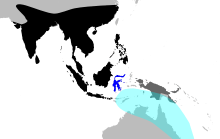Pacific koel
The Pacific koel (Eudynamys orientalis), also known as the eastern koel, is a species of cuckoo in the family Cuculidae. In Australia, it is colloquially known as the rainbird or stormbird, as its call is usually more prevalent before or during stormy weather.
| Pacific koel | |
|---|---|
| Male | |
| Female | |
| Scientific classification | |
| Kingdom: | Animalia |
| Phylum: | Chordata |
| Class: | Aves |
| Order: | Cuculiformes |
| Family: | Cuculidae |
| Genus: | Eudynamys |
| Species: | E. orientalis |
| Binomial name | |
| Eudynamys orientalis (Linnaeus, 1766) | |
 | |
| Distribution of the Pacific koel in turquoise (also outside the map in southeast Australia) | |
| Synonyms | |
|
Cuculus orientalis Linnaeus, 1766 | |
Taxonomy
It has often been considered conspecific with the Asian and black-billed koels, but they are increasingly treated as a separate species.[2][3] Alternatively, the population breeding in Australia has been considered a separate species, the Australian Koel (Eudynamys cyanocephalus[4]), with the remaining taxa then considered subspecies of the Asian koel.[5]
Distribution and habitat
The Pacific koel is found in forest, woodland, plantations and gardens from Wallacea east to the Solomon Islands and south to northern and eastern Australia. The Pacific koel has not been rated by IUCN, but the Australian Koel (here included in the Pacific koel) is considered to be of Least Concern.[1]
Behaviour
The Pacific koel is a brood parasite. In Australia, their hosts are mainly large honeyeaters (especially noisy friarbirds and red wattlebirds).[6] Unlike in other parasitic cuckoos, the young do not attempt to kill the host chicks. This trait is shared with the channel-billed cuckoo, which – as in the Pacific koel – are largely frugivorous as adults.[7] A study of vocalization noted that the duetting behaviour may indicate the possibility of short-term pair-bonding in its otherwise polygynous mating system.[8]
Gallery
References
- BirdLife International (2012). "Eudynamys orientalis". IUCN Red List of Threatened Species. 2012. Retrieved 16 July 2012.CS1 maint: ref=harv (link)
- Gill, F., Wright, M. & Donsker, D. (2009). IOC World Bird Names (version 2.0). Accessed 21-04-2009.
- Christidis, L. & Boles, W. E. (2008). Systematics and Taxonomy of Australian Birds. ISBN 978-0-643-06511-6
- David, N., & Gosselin, M. (2002). The grammatical gender of avian genera. Bull B.O.C. 122: 257-282.
- Clements, J. F. (2007). The Clements Checklist of the Birds of the World. 7th edition. Christopher Helm. ISBN 978-0-7136-8695-1
- Payne, R. B. (2005). The Cuckoos. Oxford University Press. ISBN 0-19-850213-3.
- Broom, M., Ruxton, G. D., & Kilner, R. M. (2007). Host life-history strategies and the evolution of chick-killing by brood parasitic offspring. Behavioral Ecology doi:10.1093/beheco/arm096 Full text.
- Maller, C. J., & Jones, D. N. (2001). Vocal behaviour of the Common Koel, Eudynamys scolopacea, and implications for mating systems. Emu 101(2):105-112
- Payne, R. B. (1997) Eudynamys scolopacea (Common Koel). pp. 570–571 in: del Hoyo, J.; Elliot, A. & Christie, D. (editors). (1997). Handbook of the Birds of the World. Volume 4: Sandgrouse to Cuckoos. Lynx Edicions. ISBN 84-87334-22-9
